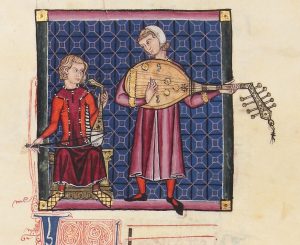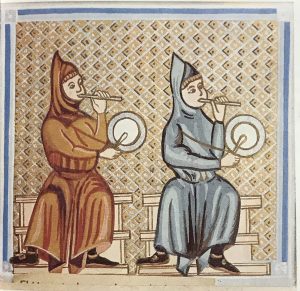4. Music in Medieval Courts
Like the Catholic Church, medieval kings, dukes, lords and other members of the nobility had resources to sponsor musicians to provide them with music for worship and entertainment. Individuals roughly comparable to today’s singer-songwriters served courts throughout Europe. Like most singer-songwriters, love was a favored topic. These poet-composers also sang of devotion to the Virgin Mary and of the current events of the day.
Many songs that merge these two focus points appear in a late 13th-century manuscript called the Cantigas de Santa Maria (Songs for the Virgin Mary), a collection sponsored by King Alfonso the Wise who ruled the northwestern corner of the Iberian peninsula. Cantigas de Santa Maria also includes many illustrations of individuals playing instruments. The musician on the left in Figure 2.9 is playing a rebec and the one to the right a lute. Appearing elsewhere in the manuscript are some drum and fife players (Figure 2.10). These depictions suggest to us that, outside of worship services, much vocal music was accompanied by instruments. We believe such songs as these were also sung by groups and used as dance music, especially as early forms of rhythmic notation indicate simple and catchy patterns that were danceable. Other manuscripts also show individuals dancing to the songs of composers such as Machaut.


Focus Composition: “Pero que seja a gente d’outra lei [e]descreuda” (“The Virgin will aid those who most love her”) from Cantigas de Santa Maria (Songs for the Virgin Mary), No. 181
“The Virgin will aid those who most love her,” is one of over four hundred songs praising the Virgin Mary in the Cantigas de Santa Maria. “The Virgin will aid those who most love her” praises Mary for her help during the crusades in defeating a Moroccan king in the city of Marrakesh. It uses a verse and refrain structure similar to those discussed in Chapter 1. Its two-lined chorus (here called a refrain) is sung at the beginning of each of the 8 four-lined strophes that serve as verses. The two-line melody for the refrain is repeated for the first two lines of the verse; a new melody then is used for the last two lines of the verse. In the recent recording done by Jordi Savall and his ensemble, a relatively large group of men and women sing the refrains, and soloists and smaller groups of singers perform the verses. The ensemble also includes a hand drum that articulates the repeating rhythmic motives, a medieval fiddle, and a lute, as well as medieval flutes and shawms, near the end of the excerpt below. These instrumental parts are not notated in the manuscript, but it is likely that similar instruments would have been used to accompany this monophonic song in the Middle Ages.
Listening Guide
Jordi Savall and Ensemble
Listen through 3:29.
Composer: Anonymous
Composition: “Pero que seja a gente d’outra lei [e]descreuda” (“The Virgin will aid those who most love her”) from Songs for the Virgin Mary
Date: c. 1275
Genre: song
Form: refrain [A] & verses [ab] = A-ab
Nature of Text: refrain and strophes in an earlier form of Portuguese, praising the Virgin Mary
Watch this on YouTube to find the text translation in the description box under the video.
Performing Forces: small ensemble of vocalists, men and women singing together and separately
What we want you to remember about this composition:
- It is music for entertainment, even though it has a sacred subject. It is music for entertainment, even though it has a sacred subject.
- It is monophonic.
- Its narrow-ranged melody and repetitive rhythms make it easy for non-professionals to sing.
Other things to listen for:
- In this recording, the monophonic melody is sung by men and women and is played by a medieval fiddle and lute. A drum plays the beat, and near the end of the excerpt, the flutes and shawms can be heard.
- Its musical form is A-ab, meaning that the refrain is always sung to the same music.
| Timing | Performing Forces, Melody, and Texture |
Text and Form |
| 0:13 | Fiddles and lute playing melody for refrain; drum playing rhythmic motive; monophonic texture throughout; mostly conjunct melody with a narrow range; repeated motive shifting back and forth between twos and threes. | A: Intro |
| 0:25 | Sung by men and women | A: Refrain |
| 0:36 | One woman starts and then others join, singing monophonically the same melodic phrase as the refrain. | a: First two lines of the first verse |
| 0:50 | Several women singing a different melodic phrase with a monophonic texture | b: Second two lines of the first verse |
| 1:02 | Men and women; same melody as in the Refrain above | A: Refrain |
| 1:14 | One man, joined by other men; same melody as in the first half of the verse above | a: First two lines of the second verse |
| 1:27 | Several men; same melody as in the second half of the verse above | b: Second two lines of the second verse |
| 1:39 | Men and women; same melody as in the Refrain above | A: Refrain |
| 1:51 | Women singing the same melody as the other verses; men joining them for the b phrase of the melodic theme | ab: Verse 3 |
| 2:16 | Men and women | A: Refrain |
| 2:28 | Men start and women sing the b phrase of the melodic theme. | ab: Verse 4 |
| 2:53 | Men and women | A: Refrain |
| 3:05 | Played by flutes, medieval fiddle, lutes, drums, and zither | a: First two lines of Verse 5 |
| 3:19 | Played by the same instruments as above | b: Second two lines of Verse 2 |
| 3:31 | Played by the above instruments plus shawms | A: Refrain |
Medieval poet composers also wrote a lot of music about more secular love, a topic that continues to be popular for songs to the present day. Medieval musicians and composers, as well as much of European nobility in the Middle Ages, were particularly invested in what we call courtly love. Courtly love is love for a beloved, without any concern for whether or not the love will be returned. The speakers within these poems recounted the virtues of their beloved, acknowledging the impossibility of ever consummating their love and pledging to continue loving their beloved to the end of their days.
Focus Composition: “Dame, à vous sans retollir” (“Lady, to you without reserve I give my heart, thought and desire”) by Guillaume de Machaut
Guillaume de Machaut, who wrote the famous Mass of Notre Dame discussed earlier in the chapter, also wrote many love songs, some polyphonic and others monophonic. In his “Lady, to you without reserve I give my heart, thought and desire,” a lover admires his virtuous beloved and pledges undying love, even while suspecting that they will remain ever apart. Like “The Virgin will aid,” its sung words are in the original French. Also like “The Virgin will aid,” it consists of a refrain that alternates with verses. Here the refrain and three verses are in a fixed medieval poetic and musical form that can be notated as Abba-Abba-Abba-A. Machaut’s song, written over fifty years after “The Virgin will aid,” shows medieval rhythms becoming increasingly complex. The notes are grouped into groups of three, but the accentuation patterns often change. We think that this song was also used as dance music, given the illustration of a group dancing in a circle appearing above its musical notation in Machaut’s manuscript. As we noted earlier, songs like this were most likely sung with accompaniment, even though this accompaniment wasn’t notated. The recording excerpt in the link below uses tambourine to keep the beat.
Listening Guide
Studio der Frühen Musik
Composer: Guillaume de Machaut (c. 1300–1377)
Composition: “Dame, à vous sans retollir” (“Lady, to you without reserve I give my heart, thought and desire”)
Date: 14th century
Genre: song
Form: refrain [A] & verses [bba]
Nature of Text: French poem about courtly love with a refrain alternating with three verses
See the full text and translation here.
Performing Forces: soloist alternating with small ensemble of vocalists
What we want you to remember about this composition:
- It is a French song about courtly love.
- It is monophonic, but here with tambourine articulating the beats.
- Its form consists of an alternation of a refrain and verses.
Other things to listen for:
- Its melodic line is mostly conjunct, the range is a little over an octave, and it contains several short melismas.
- Its specific form is Abba, which repeats three times.
| Timing | Performing Forces, Melody, and Texture |
Text and Form |
| 0:00 | Small group of women singing in monophonic texture with tambourine; mostly conjunct melody within a narrow range; notes fall in rhythmic groups of three, but the accentuation patterns change often | A: Refrain |
| 0:14 | Female soloist still in monophonic texture but without tambourine; the b phrase is mostly conjunct, starting high and descending, repeating, then returning to the a phrase as heard in the refrain. | bba: Verse |
| 0:40 | Same music as in the A phrase above with the words of the refrain | A: Refrain |
| 0:53 | Female soloist as heard above, with new words | bba: Verse |
| 1:18 | As heard in the Refrain above, words and music | A: Refrain |
| 1:31 | Music as heard above verses, with new words | bba: Verse |
| 1:57 | As heard in the Refrain above, words and music | A: Refrain |
A repeating musical section, generally also with repeated text; sometimes called a “chorus”.
Love for a beloved, without any concern for whether or not the love will be returned, called “courtly” because it was praised by those participating in medieval courts.
